Instructions for connecting a computer to a projector, connecting a laptop to a projector
1. How to connect the computer to the projector using an HDMI cable
Connecting a projector to a laptop using an HDMI cable will give better image quality because it transmits an uncompressed signal. Depending on which standard your HDMI cable belongs to, it can produce images at what resolution (the highest currently is HDMI 2.1, which can transmit 8K content).
Below are 5 steps to connect a projector to a laptop using an HDMI cable:
Step 1: Turn on the projector
Step 2: Turn on the computer/laptop
Step 3: Plug one HDMI end into the HDMI port on the projector (circled in red in the picture).
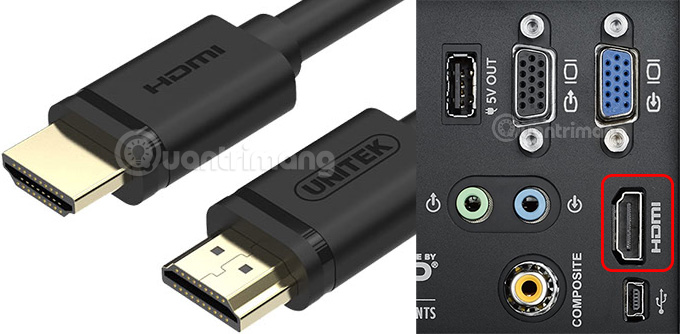
Step 4: Plug the other end of the HDMI cable into the HDMI port on the computer/laptop:

Step 5: After plugging in the cable, the computer screen will usually appear on the projector. If you don't see it yet, then press the Windows key + P on the keyboard, select the mode to display the computer screen on the projector. Duplicate (displayed exactly like the laptop screen), Extend (only the parts pulled to the projector screen will be displayed).

2. Connect the projector to the laptop using a VGA cable
To connect the projector to a laptop using a VGA cable, you need to prepare a VGA cable, then follow the steps below.
Step 1: Turn on the projector by pressing the POWER button once on the remote or projector. If you see the light on the projector turn green, it's okay. If the projector has just turned off, you need to wait a few seconds for the fan in the machine to stop spinning and then press it to turn it on again.
Step 2: Turn on the computer/laptop
Step 3: Plug one end of the cable into the VGA port on the projector (usually blue).
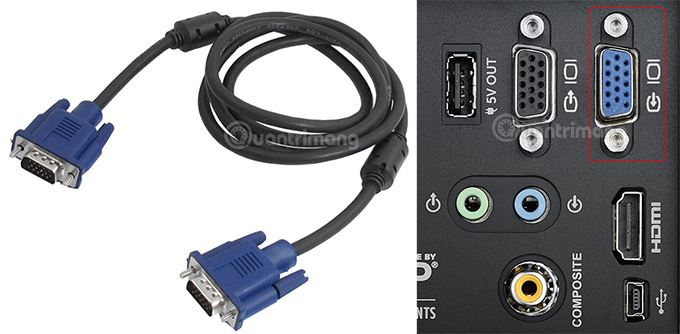
Step 4: Plug the other end of the VGA cable into the VGA port on your laptop or computer. You need to insert the correct connector, push it firmly into the slot and insert it tightly. When removing the cord, we will hold the end and pull it out, avoiding bending up or down the plug.
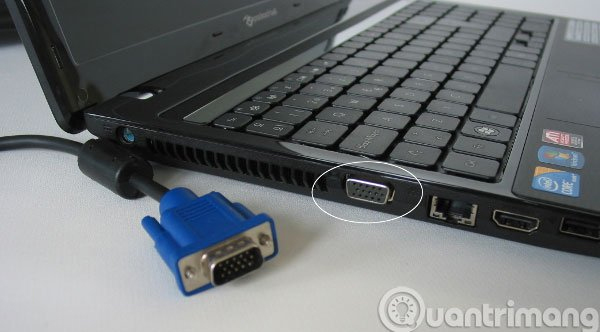
Step 5:
When the connection is successful, the computer screen will appear on the projector. If there is no signal, press the Auto Setup button on the remote again to let the projector detect the signal from the computer again.
Step 6:
If the laptop screen is not displayed on the projector even though it has been successfully connected, press the Windows + P key combination and select Duplicate . If it still doesn't work, continue reading how to fix the error connecting the projector to the computer below.
3. Connect the projector to the computer via WiFi
To connect your computer to the projector via WiFi, you need to pay attention to the following issues:
- The projector supports connection via WiFi.
- The devices that need to be connected (computer and projector) need to be connected to the same WiFi network.
- WiFi connection is very convenient but sometimes it will not be as stable as connecting via HDMI or VGA cable.
Steps:
Step 1 : You need to connect a projector that supports WiFi connection to a common WiFi network. This setting depends on the projector type but can be found in Settings > Network . Then you need to set up the Screen Mirroring feature to allow receiving image signals over WiFi.
Step 2 : On a Windows computer, press Windows + S then type Connect to wireless display , click on the result in the search section.
Step 3 : Find and click the Connect to a wireless display section .
Step 4 : Click Detect to find the name of the projector to connect, then select and click Connect.
With a Mac computer, you can connect to the projector via AirPlay. Of course, to do this, you also need a projector model that supports AirPlay connection. First, you need to connect the projector to a common WiFi network and then activate AirPlay (usually in the same place as the Screen Mirroring option).
On a Mac, click the AirPlay button then find the projector and click to connect.
4. How to fix errors connecting the projector to the computer
As mentioned, during the process of connecting the computer to the projector, there may be an error of no signal, or no image recognition due to incorrect implementation or other errors. Readers can refer to some error correction methods in the section below.
Method 1: Press the shortcut key combination on the computer
Depending on the type of laptop connected to the projector, we press different key combinations. But first, we need to select LCD + Monitor mode .
- For ACER, TOSHIBA, SHARP projectors : Fn + F5.
- For SONY, IBM, LENOVO projectors : Fn + F7.
- For PANASONIC, NEC projectors : Fn + F3.
- For ASUS, DELL, EPSON projectors : Fn + F8.
- For FUJITSU projectors : Fn + F10.
- For HP, COMPAQ projectors : Fn + F4.
- Other projector models : Fn + Key with screen icon depending on the brand.
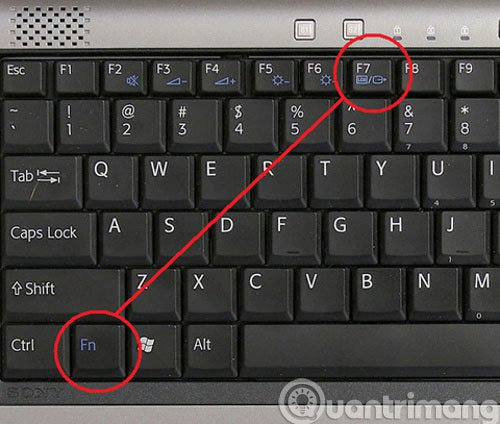
Method 2: Edit on the Desktop interface
Method 1:
Right-click and select Graphics option > Output to > Intel(R) dual display clone > Notebook + monitor .
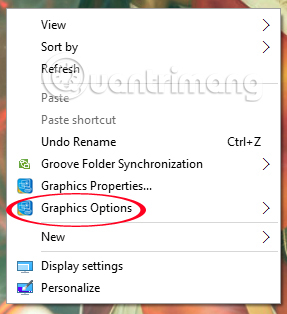
Method 2:
We also right-click and select Graphics Properties . Next, in the Muliple Display section , check Intel (R) Dual Display Clone , then click OK .
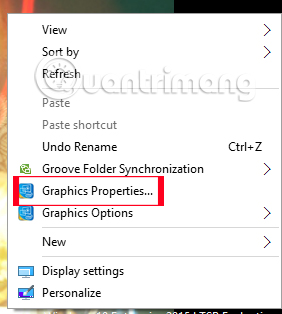
Method 3: In case the device does not have the Graphics option and Graphics Properties options
At the interface on the screen, right-click and select Properties > Settings > Advances . Next select the Intel ® Graphichs Media accelerator Driver for mobile > Graphichs properties tab .
In the Muliple Display section , we check Intel (R) Dual Display Clone and click OK .
Method 4: With Windows 7 computer
Method 1:
We press the Windows + P key combination and select Duplicate .
Method 2:
At the Desktop interface, right-click and select Graphics Options > Output to > Clone Displays > Monitor + Built-in Display .
Method 3:
On the screen, right-click and select Personalize > Display > Connect to a projector > Duplicate .
Method 4:
Click Start > All Programs > Accessories > Windows Mobility Center . In the External Display panel of Mobility Center , we click on the Connect Display option and then click Duplicate .
Method 5: Fix errors with laptops with ATI and Geforce discrete cards
1. With ATI discrete card
At the Desktop screen, right-click and select Catalyst(TM) Control Center . At the Graphics settings tab, select Display manager > Displays properties . Then right-click on the blurred screen image and click Clone main with monitor .
2. With GeForce discrete card
Right-click on the computer screen, select Nvdia Control Panel . In the Display section, select Setup multiple displays . Next, right-click on the screen 2 select Duplicate .
You can try the above methods to fix the error of not receiving signal when connecting the computer to the projector. Depending on the projector model being used, the remote will have a Shutter or Avmute key to put the projector into Standby mode and temporarily turn off the device. To restart, you only need to press the above buttons once.
You should read it
- How to connect a Mac to a projector
- How to connect Android wirelessly to the projector
- How to connect a tablet to a projector
- How to connect laptop to TV? 5 ways to connect the TV to laptop
- N-Tech, a cheap 4K projector, all in one, wireless, compact
- How to connect laptop to TV via HDMI port
- Fujitsu laptop and projector
- Object projector and things to know
May be interested
- Instructions for using the cable to connect MacBook to projector most easily
 you don't know how to use the cable to convert from macbook to projector? instructions for using the cable to connect macbook to projector easily and quickly.
you don't know how to use the cable to convert from macbook to projector? instructions for using the cable to connect macbook to projector easily and quickly. - Object projector and things to know
 projectors are becoming increasingly popular and are widely used in the fields of life and work.
projectors are becoming increasingly popular and are widely used in the fields of life and work. - 10 Ways to Fix Projector Not Working and Related Errors
 10 ways to fix projectors that don't display images and related errors in the most detailed way from a to z for your reference.
10 ways to fix projectors that don't display images and related errors in the most detailed way from a to z for your reference. - 8 best 4K projectors today
 for the best possible experience, you also need to take picture quality into account, and 4k is the highest resolution accessible to most of us.
for the best possible experience, you also need to take picture quality into account, and 4k is the highest resolution accessible to most of us. - What connection ports do projectors usually have?
 projectors have connections for devices ranging from laptops to game consoles. this can make it difficult to find the right input or output. let's learn about the types of connectors for projectors through the following article!
projectors have connections for devices ranging from laptops to game consoles. this can make it difficult to find the right input or output. let's learn about the types of connectors for projectors through the following article! - Fix iPhone error not connecting to computer
 you are not the only one experiencing the iphone not connecting to the computer error. many people are facing this annoying problem. the cause could be something as simple as a broken cable, a driver issue, or a faulty version of itunes.
you are not the only one experiencing the iphone not connecting to the computer error. many people are facing this annoying problem. the cause could be something as simple as a broken cable, a driver issue, or a faulty version of itunes. - How to connect the network between two laptops using a network cable
 if you want to connect the network between two laptops, we can use the network cable and then change the ip address of the two computers to finish.
if you want to connect the network between two laptops, we can use the network cable and then change the ip address of the two computers to finish. - N-Tech, a cheap 4K projector, all in one, wireless, compact
 just a few years ago, we were surprised when sony released the first 4k home theater projector at a retail price of us $ 26,000. now, switch to 2018 and we have a wireless n-tech 4k projector, surround sound for only $ 475.
just a few years ago, we were surprised when sony released the first 4k home theater projector at a retail price of us $ 26,000. now, switch to 2018 and we have a wireless n-tech 4k projector, surround sound for only $ 475. - Top 5 best mini projectors 2018
 the projector is a great device for enjoying movies or videos. with the advancement of technology, the projector has become more compact and efficient. this article will introduce you to the list of the top 5 best mini projectors 2018.
the projector is a great device for enjoying movies or videos. with the advancement of technology, the projector has become more compact and efficient. this article will introduce you to the list of the top 5 best mini projectors 2018. - Experience spring home entertainment with Xiaomi Smart Projector L1 Pro
 xiaomi smart projector l1 pro is suitable for every family thanks to its compact size, brightness up to 400 lumens, vivid dolby sound, google tv and netflix available, while the price is affordable and there are promotions during the tet holiday.
xiaomi smart projector l1 pro is suitable for every family thanks to its compact size, brightness up to 400 lumens, vivid dolby sound, google tv and netflix available, while the price is affordable and there are promotions during the tet holiday.










 How to fix Bluetooth headset error where only one side can be heard
How to fix Bluetooth headset error where only one side can be heard How to replace mouse with keyboard via Auto Mouse (RSI)
How to replace mouse with keyboard via Auto Mouse (RSI) What is Wifi 7? Top 5 Wifi 7 transmitters worth buying today
What is Wifi 7? Top 5 Wifi 7 transmitters worth buying today Should I buy an AMD laptop? Advantages and disadvantages you need to know
Should I buy an AMD laptop? Advantages and disadvantages you need to know Why should you not buy an iPad Pro with nano texture glass?
Why should you not buy an iPad Pro with nano texture glass? 5 Best NAS for Plex in 2024
5 Best NAS for Plex in 2024